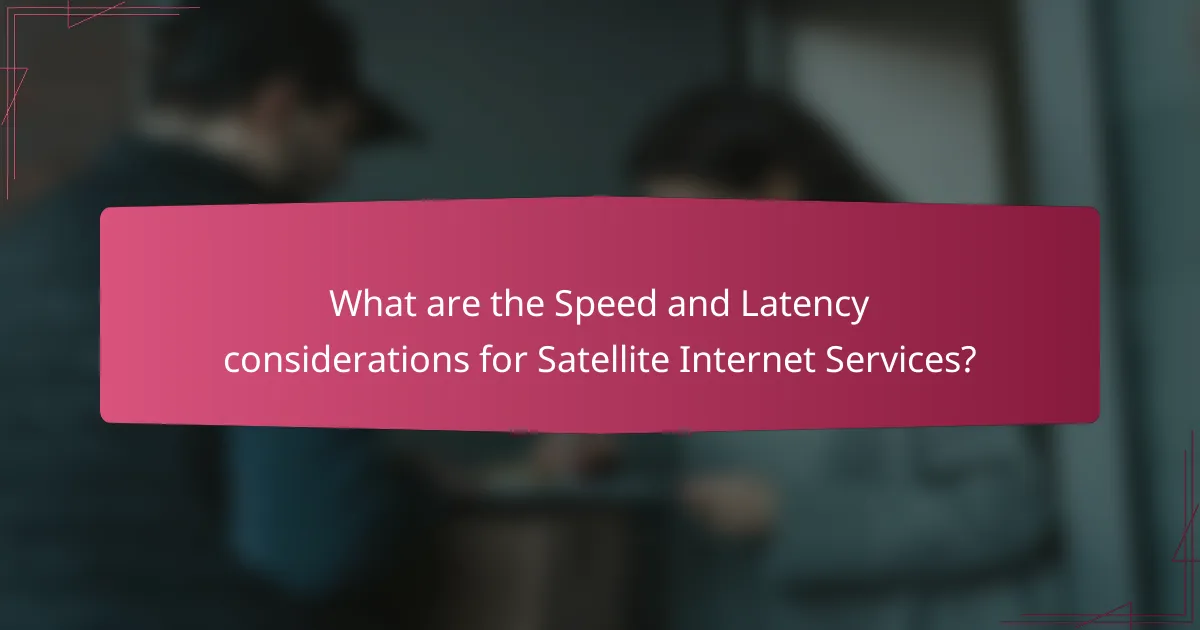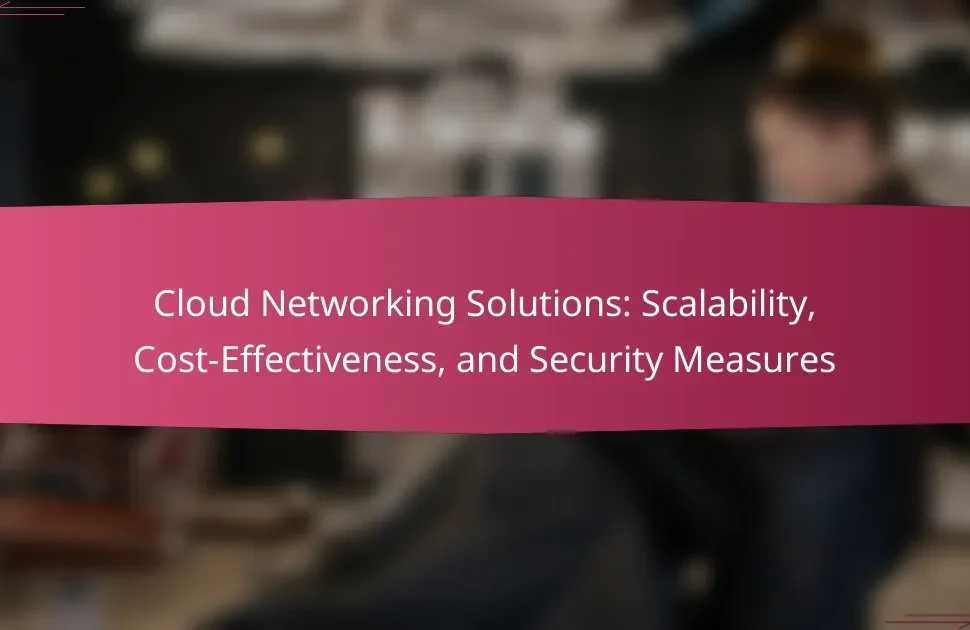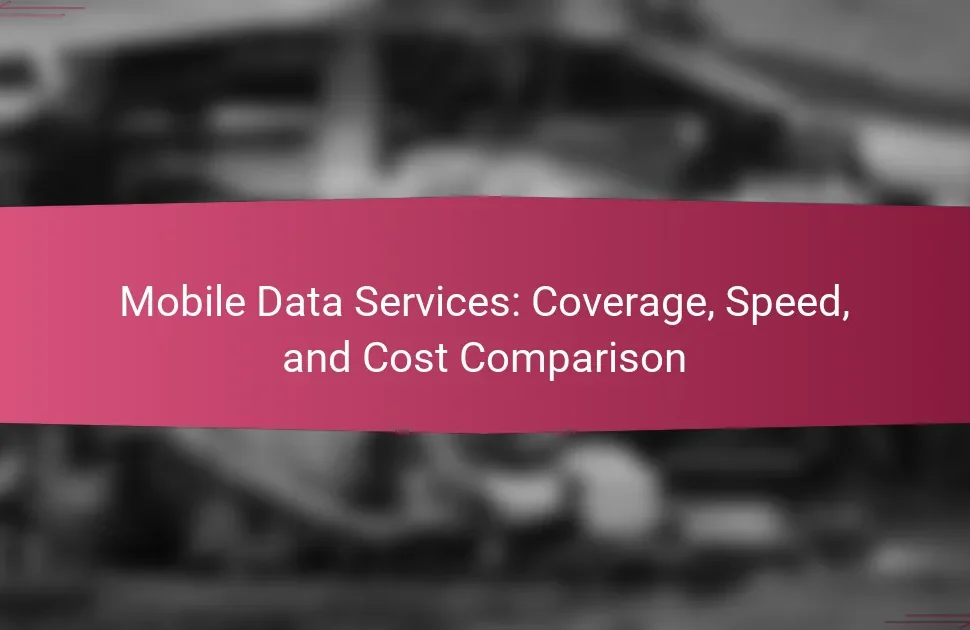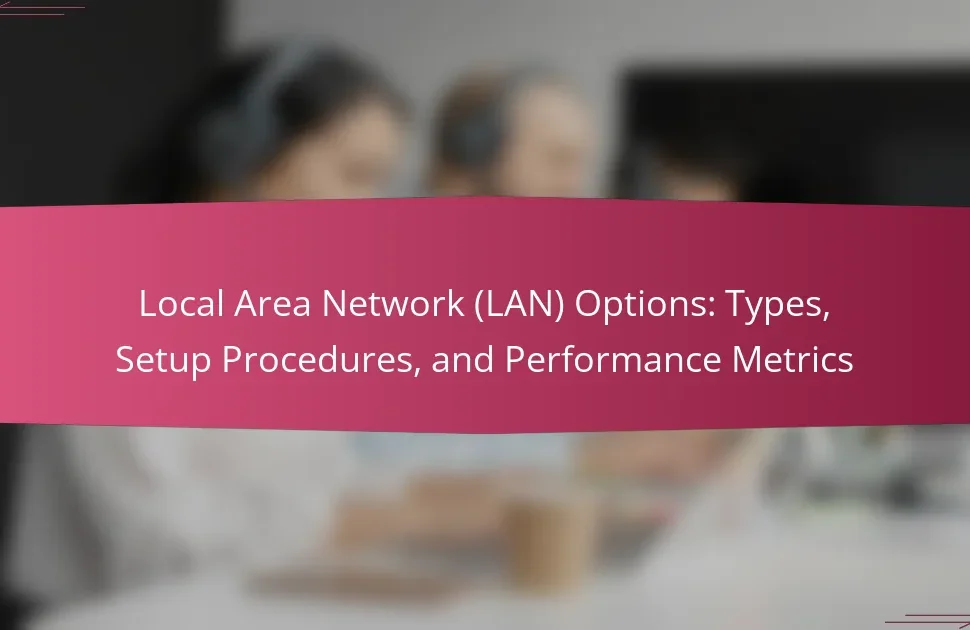
What are Satellite Internet Services?
Satellite Internet services are a type of internet connectivity that uses satellite technology. They transmit data to and from satellites orbiting the Earth. This allows users in remote or rural areas to access the internet where traditional services may not be available. Satellite internet typically involves a satellite dish installed at the user’s location. The dish communicates with satellites that relay the internet signal. According to the Federal Communications Commission (FCC), satellite internet can provide speeds ranging from 12 Mbps to 100 Mbps. However, latency can be higher than other internet types, often exceeding 600 milliseconds. This is due to the long distance data must travel to and from the satellite.
How do Satellite Internet Services operate?
Satellite Internet Services operate by transmitting data between a user’s satellite dish and a satellite in orbit. The user’s dish sends signals to the satellite, which relays them to ground stations. These ground stations are connected to the internet backbone. The satellite then transmits data back to the user’s dish, completing the communication loop. This system enables internet access in remote areas where traditional cables are not available. The latency in satellite internet can be higher due to the distance the signals must travel. Typically, signals travel to satellites approximately 22,000 miles above the Earth. This distance results in noticeable delays compared to terrestrial internet services.
What technology underpins Satellite Internet Services?
Satellite Internet services are primarily underpinned by satellite technology. This involves the use of geostationary satellites positioned approximately 22,236 miles above the Earth. These satellites relay signals between the ground stations and users’ satellite dishes. The technology includes frequency bands such as Ku-band and Ka-band for data transmission. Satellite Internet utilizes modulation techniques like QPSK and 8PSK to optimize bandwidth. The system experiences latency due to the long distance signals must travel. Typical latency ranges from 500 ms to 600 ms, which can affect real-time applications. These technologies enable connectivity in remote and underserved areas where traditional broadband is unavailable.
What are the key components of a Satellite Internet system?
A Satellite Internet system consists of several key components. These include a satellite dish, a satellite modem, and a satellite in orbit. The satellite dish receives signals from the satellite. The satellite modem converts these signals into internet data. The satellite in orbit facilitates communication between the dish and internet service providers. These components work together to provide internet access. The system’s effectiveness depends on the alignment and quality of each component.
What are the advantages of Satellite Internet Services?
Satellite Internet services provide high-speed internet access in remote and rural areas. They are particularly beneficial where traditional cable or DSL connections are unavailable. Satellite technology enables connectivity regardless of geographical barriers. This service typically offers wide coverage, making it accessible to users in underserved regions.
Additionally, satellite internet can deliver faster speeds compared to some DSL services. Many satellite providers offer plans with speeds ranging from 25 Mbps to over 100 Mbps. These services often have lower latency than older satellite technologies. Modern low-Earth orbit satellites significantly reduce the delay in data transmission.
Furthermore, satellite internet is easy to install, requiring minimal infrastructure. Users can quickly set up satellite dishes and modems for immediate service. Overall, satellite internet services enhance connectivity options, especially in hard-to-reach locations.
How do Satellite Internet Services enhance connectivity in remote areas?
Satellite Internet Services enhance connectivity in remote areas by providing access where traditional methods fail. These services utilize satellites orbiting the Earth to transmit data directly to users. This technology eliminates the need for physical infrastructure like cables and fiber optics. Remote locations often lack these infrastructures, making satellite solutions essential. For instance, companies like SpaceX’s Starlink aim to deliver high-speed internet globally, even in underserved regions. According to a report by the Federal Communications Commission, satellite internet can reach nearly every corner of the globe. This capability significantly improves communication, education, and economic opportunities in isolated communities.
What unique benefits do Satellite Internet Services provide for businesses?
Satellite Internet Services provide unique benefits for businesses, including global coverage and high-speed connectivity. These services are particularly advantageous in rural or remote areas where traditional broadband options may be limited. Satellite Internet can deliver speeds up to 100 Mbps, enabling efficient operations and communication. Additionally, it offers reliable service during natural disasters when terrestrial networks may fail. Businesses benefit from quick deployment, as satellite installations can be set up rapidly without extensive infrastructure. Furthermore, satellite services support mobile operations, allowing businesses to maintain connectivity while on the move. These advantages make satellite Internet an essential tool for companies seeking to enhance their operational capabilities.

How does Accessibility affect Satellite Internet Services?
Accessibility significantly impacts satellite internet services by determining their availability in various regions. Areas with difficult terrain or limited infrastructure often face challenges in receiving satellite signals. This can lead to slower internet speeds and increased latency for users in remote locations. According to the Federal Communications Commission, approximately 19 million Americans lack access to high-speed internet, with many relying on satellite services. Additionally, the cost of satellite equipment can be a barrier to accessibility for some users. Overall, accessibility influences both the performance and reach of satellite internet services.
What factors influence the accessibility of Satellite Internet Services?
The accessibility of Satellite Internet Services is influenced by several key factors. Geographic location plays a significant role; rural and remote areas often have limited options. The type of satellite technology used also impacts accessibility. For example, newer low Earth orbit (LEO) satellites provide better coverage than traditional geostationary satellites.
Weather conditions can affect signal quality and availability. Heavy rain or storms can disrupt service. Regulatory policies and licensing requirements can also limit access in certain regions. Infrastructure investment is crucial; areas with better ground stations and equipment typically experience improved service.
User equipment requirements, such as satellite dishes and modems, can also affect accessibility. Finally, market competition influences pricing and service availability, impacting overall access to satellite internet.
How do geographical locations impact Satellite Internet availability?
Geographical locations significantly impact Satellite Internet availability. Rural and remote areas often have limited or no access to traditional broadband services. Satellite Internet provides a viable alternative in these regions. However, availability is influenced by factors like the satellite’s coverage area. Urban locations typically experience better service due to higher infrastructure investments. Terrain can obstruct signals, affecting service quality in mountainous or heavily forested regions. Additionally, regulatory restrictions in certain countries can limit satellite service deployment. According to the Federal Communications Commission, approximately 14 million Americans lack access to broadband, highlighting the role of geography in service availability.
What role do regulatory policies play in Satellite Internet accessibility?
Regulatory policies significantly influence Satellite Internet accessibility. They establish the framework for licensing satellite operators. This ensures that service providers meet specific standards. Policies also promote competition among providers. Increased competition can lead to better service and lower prices. Furthermore, regulations can mandate coverage in underserved areas. This is vital for expanding access to remote populations. For example, the Federal Communications Commission (FCC) in the U.S. has initiatives to improve broadband access. Such initiatives help bridge the digital divide. Overall, regulatory policies are essential for shaping the landscape of Satellite Internet services.
What challenges exist regarding Satellite Internet accessibility?
Satellite Internet accessibility faces several challenges. One major challenge is high latency, which can affect real-time applications. Latency can reach up to 600 milliseconds due to the distance signals must travel to satellites in orbit. Additionally, weather conditions can disrupt signals, leading to inconsistent service.
Geographical limitations also play a role. Remote areas may lack ground infrastructure for satellite dishes or receivers. Furthermore, installation costs can be prohibitive for some users. The technology requires specialized equipment, which can be expensive.
Bandwidth limitations are another concern. Many satellite providers impose data caps, which can restrict usage. This is especially problematic for households with multiple users or heavy data needs.
Lastly, competition with terrestrial Internet options can limit satellite uptake. In areas with fiber or cable service, consumers may prefer those faster, more reliable options.
How do weather conditions affect Satellite Internet access?
Weather conditions significantly affect Satellite Internet access. Rain, snow, and heavy cloud cover can disrupt the signal between satellites and ground stations. This phenomenon is known as rain fade, where raindrops absorb and scatter the satellite signals. Studies indicate that a 1 dB increase in rain rate can lead to a 10% loss in signal strength. Snow accumulation on satellite dishes can also obstruct signals, leading to connectivity issues. Wind can cause physical misalignment of satellite dishes, further degrading service. Overall, adverse weather can lead to slower speeds and higher latency in Satellite Internet access.
What are the limitations of Satellite Internet in urban versus rural settings?
Satellite Internet faces several limitations in urban and rural settings. In urban areas, high-density buildings can obstruct satellite signals. This results in reduced connection quality and increased latency. Additionally, urban environments often have more competing internet options, making satellite less attractive. In contrast, rural areas suffer from limited infrastructure. Satellite Internet can provide better access in these locations. However, rural users often experience higher latency due to the distance signals must travel. Moreover, bandwidth can be limited in rural settings due to fewer available satellites. Overall, urban limitations stem from physical obstructions and competition, while rural limitations are primarily due to infrastructure and latency issues.

What are the Speed and Latency considerations for Satellite Internet Services?
Satellite Internet services typically experience higher latency compared to other types of internet connections. This latency arises from the long distance signals must travel to and from satellites in orbit. Latency for satellite internet can range from 500 milliseconds to over 700 milliseconds. This delay can impact activities such as online gaming and video conferencing.
Speed is another critical consideration for satellite internet. Download speeds can vary significantly, often ranging from 12 Mbps to 100 Mbps depending on the service provider and technology used. Upload speeds are generally lower, often between 3 Mbps to 25 Mbps.
Weather conditions can also affect both speed and latency in satellite internet services. Heavy rain or snow can disrupt signals, leading to slower speeds or temporary outages. Additionally, network congestion during peak usage times can further reduce performance.
In summary, satellite internet services face challenges with both speed and latency that can impact user experience.
How is speed measured in Satellite Internet Services?
Speed in Satellite Internet Services is measured in megabits per second (Mbps). This unit quantifies the rate of data transfer. It indicates how quickly data can be downloaded or uploaded. Satellite internet speed is influenced by several factors. These include satellite distance, weather conditions, and network congestion. Typically, download speeds range from 12 Mbps to 100 Mbps. Upload speeds are usually lower, often between 3 Mbps and 25 Mbps. Latency is also a critical factor, affecting the responsiveness of the connection. Latency in satellite internet can range from 500 milliseconds to 600 milliseconds due to the distance signals must travel to and from satellites.
What factors contribute to the speed of Satellite Internet connections?
The speed of Satellite Internet connections is influenced by several key factors. These include satellite altitude, bandwidth, and latency. Satellite altitude affects the distance signals must travel. Higher satellites, like geostationary ones, are about 22,236 miles above Earth. This distance increases latency, which can slow down the connection. Bandwidth determines how much data can be transmitted simultaneously. Limited bandwidth can lead to slower speeds, especially during peak usage times. Weather conditions also impact speed by causing signal interference. Rain, snow, and heavy clouds can degrade the connection quality. Additionally, user equipment quality, such as satellite dishes and modems, plays a critical role in speed performance. Higher quality equipment can enhance signal reception and overall speed.
How do different service providers compare in terms of speed?
Different satellite internet service providers vary significantly in terms of speed. For instance, SpaceX’s Starlink offers speeds ranging from 50 Mbps to 200 Mbps. HughesNet typically provides speeds up to 25 Mbps. Viasat can deliver speeds between 12 Mbps and 100 Mbps depending on the plan. These differences arise from varying satellite technology and network infrastructure. Starlink’s low Earth orbit satellites allow for higher speeds compared to traditional geostationary satellites used by HughesNet and Viasat. According to a report by PCMag, Starlink consistently ranks highest in speed among satellite providers.
What is latency and why is it important for Satellite Internet Services?
Latency is the time delay experienced in data transmission. In satellite Internet services, latency is crucial because it affects the speed of communication between the satellite and the user. Satellite signals must travel to space and back, resulting in higher latency compared to terrestrial connections. Typically, latency for satellite Internet can range from 500 milliseconds to 1 second. This delay can impact activities like video conferencing and online gaming, which require real-time interaction. Lower latency improves user experience by enabling smoother communication and faster response times. Therefore, understanding and managing latency is essential for optimizing satellite Internet performance.
How does latency affect user experience in Satellite Internet Services?
Latency significantly impacts user experience in Satellite Internet Services. High latency leads to delays in data transmission. This can result in slow loading times for websites and applications. Users may experience interruptions during video calls or streaming. Gaming experiences can be negatively affected due to lag. Latency in satellite connections can average 600 milliseconds or more. This is primarily due to the long distance data must travel to and from satellites. Users often find this frustrating, as it hampers real-time interactions. Consequently, high latency can reduce overall satisfaction with satellite internet services.
What are the typical latency levels for Satellite Internet compared to other types of internet?
Satellite Internet typically has latency levels ranging from 500 to 600 milliseconds. This is significantly higher than other types of internet. For example, fiber-optic internet generally has latency levels under 20 milliseconds. Cable internet typically ranges from 10 to 30 milliseconds. DSL connections can have latencies between 30 to 100 milliseconds. The high latency in satellite internet is primarily due to the long distances signals must travel to and from satellites in orbit. This delay can impact real-time applications such as online gaming and video conferencing.
What are the best practices for optimizing Satellite Internet performance?
To optimize Satellite Internet performance, users should ensure a clear line of sight to the satellite. This reduces obstructions that can cause signal degradation. Users should also position the satellite dish properly, aiming it at the satellite’s location in the sky. Proper alignment can significantly improve connection stability.
Minimizing interference from trees, buildings, or other obstacles is essential. These can block signals and lead to slower speeds. Regularly checking and maintaining the equipment is crucial. Dust and debris can accumulate and affect performance.
Using a high-quality modem and router can enhance overall connectivity. Modern devices often support better speeds and more reliable connections. Additionally, limiting the number of devices connected to the network can help maintain speed. Too many devices can overload the bandwidth.
Finally, users should consider timing their internet usage. Peak hours can lead to slower speeds due to network congestion. By using the internet during off-peak times, users can experience improved performance.
How can users reduce latency in their Satellite Internet connections?
Users can reduce latency in their Satellite Internet connections by optimizing their equipment and settings. Upgrading to a high-quality satellite modem can enhance performance. Ensuring a clear line of sight to the satellite is crucial for minimizing interruptions. Users should also limit the number of devices connected to the network to reduce congestion. Using wired connections instead of Wi-Fi can provide a more stable signal. Regularly updating firmware on routers and modems can improve efficiency. Additionally, scheduling heavy bandwidth activities during off-peak hours can help manage latency. Implementing Quality of Service (QoS) settings can prioritize important traffic, further reducing delays.
What equipment upgrades can enhance Satellite Internet speed and reliability?
Upgrading equipment can significantly enhance Satellite Internet speed and reliability. A high-quality satellite dish improves signal reception. Modern dishes are designed to have better tracking capabilities. A low-noise block downconverter (LNB) reduces signal noise. This results in clearer data transmission. A Wi-Fi router with advanced technology can distribute the connection more efficiently. Dual-band routers reduce congestion on networks. Using a signal booster can enhance coverage in larger areas. Finally, ensuring firmware is updated on all devices optimizes performance. These upgrades collectively improve overall Internet experience.
Satellite Internet Services provide connectivity through satellite technology, enabling users in remote or rural areas to access the internet where traditional services are unavailable. This article explores the operational mechanisms of satellite internet, including its key components, advantages, and the impact of accessibility on service delivery. It also examines speed and latency considerations, comparing performance metrics across different service providers and highlighting factors that influence user experience. Additionally, challenges such as weather conditions and geographical limitations are addressed, along with best practices for optimizing performance and reducing latency.




